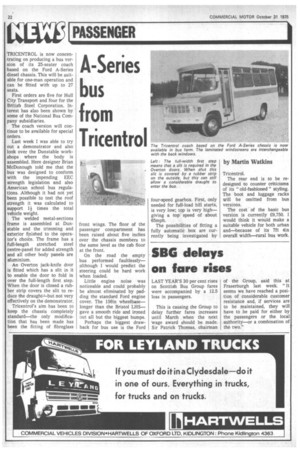A-Series bus from Tricentrol
Page 24

If you've noticed an error in this article please click here to report it so we can fix it.
by Martin Watkins
TRICENTROL is now concentrating on producing a bus version of its 25-seater coach based on the Ford A-Series diesel chassis. This will be suitable for one-man operation and can be fitted with up to 27 seats.
First orders are five for Hull City Transport and four for the British Steel Corporation. Interest has also been shown by some of the National Bus Company subsidiaries.
The coadh version will continue to be available for special orders.
Last week I was able to try out a demonstrator and also look over the Dunstable workshops where the body is assembled. Here designer Brian McDonough told me that the bus was designed to conform with the impending EEC strength legislation and also American school bus regulations. Although it had not yet been possible to test the roof strength it was calculated to support 1 times the total vehicle weight.
The welded metal-sections frame is assembled at Dunstable and the trimming and exterior finished to the operator's choice. The frame has a full-length stretched steel centre-panel for added strength and all other body panels are aluminium.
An Overton jack-knife door is fitted which has a slit in it to enable the door to fold in over the full-length first step. When the door is closed a rubber strip covers the slit to reduce the draught---but not very effectively on the demonstrator.
Tricentrol's aim has been to keep the chassis completely standard—the only modification that has been made has been the fitting of fibreglass • front wings. The floor of the passenger compartment has been raised about five inches over the chassis members to the same level as the cab floor at the front.
On the road the empty bus performed faultlessly— although I would predict the steering could be hard work when loaded.
Little engine noise was noticeable and could probably be almost eliminated by padding the standard Ford engine cover. The 156in wheelbase— longer than the Bristol LHSgave a smooth ride and ironed out all but the biggest bumps.
Perhaps the biggest drawback for bus use is the Ford four-speed gearbox. First, only needed for full-load hill starts, is very low; top is very high— giving a top speed of about 65mph.
The possibilities of fitting a fully automatic box are currently being investigated by Tricentrol.
The rear end is to be redesigned to counter criticisms of its " old-fashioned " styling. The boot and luggage racks will be omitted from bus versions.
The cost. of the basic bus version is currently £9,750. I would think it would make a suitable vehicle for both urban and—because of its 7ft 4in overall width—rural bus work.
































































































